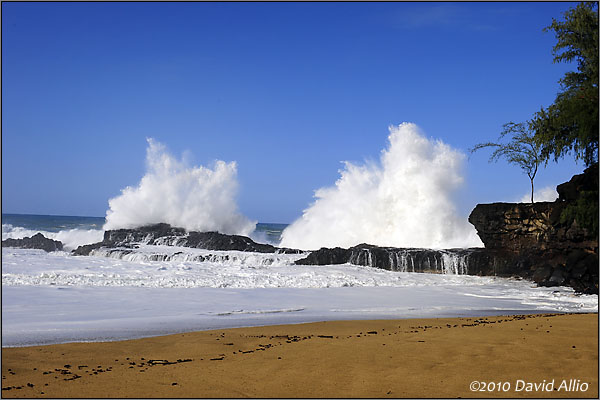Kauai Hawaii
“Do you have a favorite place to take photographs?”
This time of year, a sunny winter day on Lumahai Beach on the North Shore of Kauai fulfills my need for variety, action, solitude, and beauty. When the North Shore is cloud-covered, the sky and ocean are an unappealing and dreary shade of gray. But when the sun shines, the golden sand, thundering surf, dark lava flow, and blue sky combine to create one of the most beautiful and invigorating places in the world.

Lumahai Beach | Kauai Hawaii
Unlike summer months when the wide beach is packed with locals and tourists, in winter it is possible to spend hours on Lumahai Beach without intrusion. Although both the air and water temperatures usually remain in the mid-70s throughout the year, when the shoreline begins to erode on the North Shore, there are more popular beaches for sunning and swimming on other parts of the Garden Island.
In summer months, Lumahai Beach is an idyllic wide strip of rejuvenated sand framed by an often glass-smooth Pacific Ocean. As the seasons change, the beach disappears. Waves increase in height. And, the ocean becomes more vigorous. Along the trail to the ocean’s edge there are officially posted warning signs, along with unofficial memorials and body count markers, that serve as testimony to the dangerous surroundings. From personal experience, these warning are valid. Even after studying the ocean, observing the water for over an hour, and seeking out the safest vantage point, a rogue wave surprisingly surrounded me in neck-deep water in an area that had previously been high, dry, and protected.
In addition to safety concerns, there are other challenges to any photographer attempting to present the constantly changing scene at Lumahai Beach, including the salty ocean spray carried onshore, onto you, and onto your camera equipment by the typical 20-knot mauka wind. Then, there is the creative challenge of proper exposure. The big white plumes of spray create quite a contrast as the wave impact the black lava. Which extreme, white spray or black lava, would your in-camera meter select for an automated exposure?
Kauai and the other Hawaiian Islands are dominated by scenic settings abundant with contrast. These scenes usually lead to errors in exposure based on biased in-camera meter readings.
For this exposure, the Nikon D3 camera equipped with an AF-S Nikkor 24-70mm 1:2.8G ED lens was set to Manual. For composition, the zoom lens was set at 34mm. And, the exposure data was f/8 at 1/1000th of a second with 200 ISO as the film speed setting. The f/8 aperture provided enough depth of field to allow the whole scene to be in focus, while a shutter speed of 1/1000th of a second captured the spray in mid-air. All three exposure settings were a creative choice based on my interpretation of the scene.
In actuality, the manual settings selected for this photograph created an under-exposure of one-third of one f/stop – an exposure option carried over from traditional slide film. The slight under-exposure enhances color saturation in sunlit landscape scenes without the use of post-production software.
Aloha!
You must be logged in to post a comment.